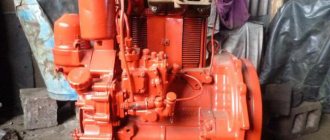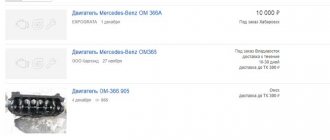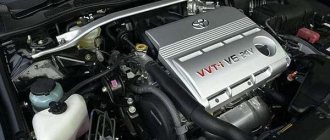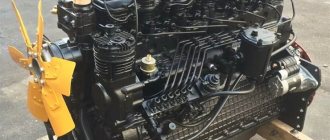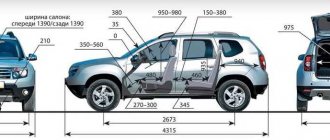The TD27 engine was created for medium-sized sea and river vessels, therefore it runs on diesel fuel, has a huge margin of reliability, rotation from the crankshaft to the camshaft is transmitted by a gear rather than a belt. Manufacturer Nissan has decided to use the TD series on several models of minivans and SUVs.
Basic version of the TD27 naturally aspirated diesel engine with attachments.
The naturally aspirated version was used very rarely, mainly on the Nissan Atlas; the turbo modifications TD27T, TD27ET and TD27ETi were more often used.
Turbocharged diesel TD27T without intercooler
Technical specifications TD27 2.7 l/85 l. With.
Initially in the manufacturer's Nissan engine with a volume of 2.7 liters of the TD series to achieve 85 hp. With. and 216 Nm technical solutions were used:
- in-line four-cylinder engine;
- cast iron cylinder head and gear transmission from the crankshaft to the camshaft and injection pump;
- valve drive by rocker arms and rods according to the OHV gas distribution scheme;
- vortex combustion chamber.
Gas distribution mechanism with lower shaft, rocker arms and pushers according to the OHV scheme
Since there is no chain/belt drive, the TD27 diesel does not bend the valve. The result was a “loud” but very reliable naturally aspirated internal combustion engine for heavy vehicles operating in harsh conditions. Within the TD series, the developers managed to increase power due to the fact that the cylinder volumes became larger.
For more detailed information, all technical characteristics of the TD27 are collected in the table:
| Manufacturer | GM DAT |
| Engine brand | TD27 |
| Years of production | 1986 – … |
| Volume | 2663 cm3 (2.7 l) |
| Power | 62.5 kW (85 hp) |
| Torque moment | 216 Nm (at 2400 rpm) |
| Weight | 250 kg |
| Compression ratio | 22 |
| Nutrition | mechanical injection pump |
| Motor type | in-line diesel four-cylinder |
| Ignition | primary ignition spark plugs |
| Number of cylinders | 4 |
| Location of the first cylinder | TVE |
| Number of valves on each cylinder | 2 |
| Cylinder head material | ductile iron |
| Intake manifold | duralumin |
| An exhaust manifold | cast iron |
| Camshaft | 8 cams, bottom position |
| Cylinder block material | cast iron |
| Cylinder diameter | 96 mm |
| Pistons | original, duralumin, 5 types of grooves |
| Crankshaft | full counterweight |
| Piston stroke | 92 mm |
| Fuel | diesel fuel |
| Environmental standards | Euro-3 |
| Fuel consumption | highway – 10 l/100 km combined cycle 12 l/100 km city – 13 l/100 km |
| Oil consumption | maximum 0.6 l/1000 km |
| What kind of oil to pour into the engine by viscosity | 20W40, 20W50 summer, 10W40 winter, 5W30 turbo |
| Which engine oil is best by manufacturer | Nissan |
| Oil for TD27 by composition | synthetics, semi-synthetics, mineral |
| Engine oil volume | 6.2 l |
| Operating temperature | 95° |
| ICE resource | declared 250,000 km actual 500,000 km |
| Adjustment of valves | nuts |
| Cooling system | forced, antifreeze |
| Coolant volume | 10 l |
| water pump | GWN-23AF, F-202, N-144 |
| Spark plugs for TD27 | PN137 HKT |
| Spark plug gap | 1.1 mm |
| Timing drive | gear |
| Cylinder operating order | 1-3-4-2 |
| Air filter | Champion CAF100105R, Bosch 1457433275, Borg&Beck BFA2345, Ashika 20-01-110 |
| Oil filter | Bosch 098AF1071, Blue Print ADN12113, Ashika 10-01-114 |
| Flywheel | 6 mounting holes and 1 landing |
| Flywheel mounting bolts | M12x1.25 mm, length 26 mm |
| Valve stem seals | 1320781W00 |
| Compression | norm 30 bar, minimum 25 bar, difference in adjacent cylinders maximum 3 bar |
| XX speed | 750 – 800 min-1 |
| Tightening force of threaded connections | spark plug – 31 – 39 Nm flywheel – 62 – 87 Nm clutch bolt – 19 – 30 Nm bearing cap – 68 – 84 Nm (main) and 43 – 53 (rod) cylinder head – three stages 20 Nm, 69 – 85 Nm + 90° + 90° |
Periodically, the owner maintains the engine with his own hands or at a service station, less often major repairs are performed, and some car enthusiasts carry out modernization to improve the parameters of the internal combustion engine. All the information necessary for this - timing for replacing antifreeze, oil and other consumables, step-by-step disassembly and assembly steps - is collected in the manual.
Technical characteristics of the TD27t motor
The Nissan TD27t engine has the following technical characteristics:
- cylinder block – cast iron R4;
- block head – cast iron with 8 valves;
- volume (cc. cm) – 2663;
- power (hp) – from 100 to 115, depending on the specific modification of the Nissan TD27d series power plant;
- torque (N*m) – from 215 to 245;
- power supply system – vortex chamber;
- gas distribution mechanism drive – gear;
- turbocharging – Garrett TB25;
- working fuel – diesel;
- phase regulator, hydraulic compensators – absent;
- cylinder diameter (mm) – 96;
- piston stroke (mm) – 92;
- compression ratio – 21,9-22;
- volume of lubricant in the motor (l) – 6;
- recommended engine oil – 10W-30;
- environmental class – Euro 1, 2, 3;
resource (thousand km) – about 380.
Fuel consumption
The TD27t engine has different diesel consumption rates. It all depends on the specific car on which it is installed . Let's look at fuel consumption using a 1997 Nissan Caravan with a manual transmission as an example:
- urban cycle - 11.4 liters per hundred kilometers;
- along the highway – 9,2;
- mixed cycle – 10,1.
Design Features
Designed for the harsh operating conditions of boats, the TD27 engine includes the following design solutions:
- cylinder head made of high-strength cast iron;
- stamped steel cylinder head valve cover;
- cast iron cylinder block with liners made of the same structural material, which allows for repeated major repairs;
- OHV valve timing system with lower camshaft, rocker arms and pushrods;
- transmission of rotation from the crankshaft to the injection pump and camshaft by gears.
The gear timing drive has a long service life and eliminates the collision of valves with pistons by 100%
An important feature of the ShPG is the presence of at least 5 options for piston grooves for an external-type vortex combustion chamber. The user manual includes a description of diesel maintenance and repair work. It is possible to boost a diesel engine on your own, but only by installing a turbocharger.
Maintainability
Despite all the above problems, TD27 engines are considered simple and reliable to maintain, and are much less likely to undergo modifications and tuning. The simple and at the same time reliable design principle ensures the ability to service them in garage conditions. The presence of sleeves in the block greatly facilitates the overhaul procedure. The motors are quite versatile - they fit perfectly with manual and automatic transmissions; they are often installed on a UAZ or gazelle instead of standard internal combustion engines.
It is worth noting that the large dimensions of a diesel engine do not always allow quick access to some components and assemblies, especially in the rear and lower parts or in areas covered by the turbine and its components. If you need to remove the entire engine for a swap or overhaul, you cannot do without the equipment of a specialized workshop.
Despite the listed negative points, the good news is that such complex manipulations are required relatively rarely, and spare parts are quite easy to order at any specialized auto store.
It's only fair to point out the positives and negatives of the TD27.
The most common problems faced by owners of diesel internal combustion engines:
- more expensive maintenance - the price of spare parts is 15-30% higher than for gasoline engines;
- significantly shorter service life of the injection pump and turbine with subsequent expensive maintenance;
- Not all technicians undertake repairs of diesel engines, so we recommend taking with you a manual that details the basic diagrams of the internal combustion engine.
The nice things about the service are:
- The service life of a diesel engine is slightly higher than that of a gasoline engine;
- There is no ignition system, so there is no need to maintain and repair it.
List of internal combustion engine modifications
In addition to the basic version of the naturally aspirated diesel engine TD27, there are modifications with turbocharging:
- TD27T – turbine without air cooler, power 98.6 hp. s., torque 230 Nm;
- TD27ti - additional attachments are used - intercooler, power and torque are 123 hp. With. and 242 Nm respectively;
- TD27eti – the intercooler is electronically controlled, torque is increased to 279 Nm, power is 130 hp. s., diesel fuel consumption is within 11 liters and 14 liters (highway/city, respectively).
In turn, the TD27T modification has several options with different ECU firmware:
- T1 – for Nissan Caravan and Homy, 100 l. With.;
- T2 – for Datsun Truck and Nisan Terrano, the power is the same, torque is reduced to 216 Nm;
- T3 – for Nissan Mistral, 243 Nm;
- T4 – for Nissan Terrano, power 113 hp. s., torque 243 Nm.
Modification of the TD27Ti diesel engine with turbocharging and intercooler
In addition to Nissan cars - Homy, Mistral, Terrano II, the characteristics of the TD27eti engine are suitable for Isuzu Eargo.
Advantages and disadvantages
Initially, an internal combustion engine with a gear drive and a mechanical injection pump has a number of advantages:
- ultra-reliable design with a service life of 300,000 km after each overhaul;
- resistance to overheating due to the cast iron head;
- low requirements for the quality of diesel fuel and lubricants.
Cast iron cylinder head in all projections for TD27 diesel engine
The main disadvantage is the poorly configured attachments. For example, when replacing the oil filter yourself, it is difficult to reach it, and it takes considerable effort to unscrew it. Other disadvantages include:
- overweight and large dimensions;
- the need to periodically adjust the thermal clearances of the valves;
- loud noise when the gear drive operates.
Technical features
Nissan engine models of the TD27t series differ in the recirculation control system used by compressors for the turbine and fuel supply pumps. The in-line power plant consists of four cylinders . Their operation is powered by diesel fuel .
The Nissan TD27t engine has an increased service life and is reliable in operation.
The design of the motor facilitates repair work . The cylinder block is equipped with removable liners. The combustion chambers are made according to the vortex operating principle . Gears distribute torque from the crankshaft to the camshaft. The latter is located at the bottom of the cylinder block. This ensures a high timing life . At the same time, there is increased noise during the operation of the internal combustion engine. The design also includes an EGR valve. The gas distribution mechanism consists of the following elements:
- push rods;
- intake and exhaust valves.
rocker arms;
The valve cover is made of steel, and the cylinder block and head are made of cast iron. There is also a significant mass of the motor.
List of car models in which it was installed
Created for river/sea vessels, the TD27 diesel engine is ideal for heavy vehicles manufactured by Nissan:
- Urvan – for the spring Asian and European markets;
- Caravan – 3rd generation minivan;
- Patrol – full-size SUV;
- Safari – for the Japanese market;
- Pasfinder – 4 generations of full-size crossover;
- Terrano – for CIS countries until 2013;
- Mistral – compact SUV;
- Atlas/Cabstar – commercial truck 1 – 1.5 tons.
Among other power drives, the Nissan Mistral SUV was equipped with a TD27 diesel engine.
Since 2013, the Nissan Terrano brand has been assigned to the more compact Renault Duster crossover, which has caused confusion among owners.
Maintenance schedule TD27 2.7 l/86 l. With.
The TD27 naturally aspirated diesel engine must be serviced within the specified periods:
- It is recommended to adjust the thermal clearances of the valves after 25,000 miles;
- cleaning of the crankcase ventilation is provided every 2 years;
- the manufacturer recommends replacing the engine oil and oil filter every 1000 km;
- the fuel filter needs to be replaced after 60,000 mileage;
- according to the manufacturer, the air filter should be updated after 35,000 km;
- the manufacturer recommends changing antifreeze after 90,000 kilometers for the first time, then every 60,000 km;
- The service life of engine spark plugs is 20,000 mileage;
- Burnout of the exhaust manifold walls is possible after 120,000 km.
Valve adjustment is included in the maintenance of the TD27 diesel engine; it can be done on your own
In severe operating conditions, the service life is reduced by 10% (mileage less than 30 thousand km) or 15% (mileage more than 30,000 km).
Service
Like any other internal combustion engine, this model also requires maintenance. A detailed schedule and operations are indicated in the vehicle passport. Nissan gives clear instructions to car owners about what and when to check or replace:
- Engine oil - replaced after 10 thousand kilometers or after 6 months if the car has not driven that much. If the machine is operated under heavy duty conditions, then it is advisable to change the lubricant after 5-7.5 thousand kilometers. This is also relevant due to the low quality of oil that is available on the Russian market.
- Oil filter - always replaced along with the oil.
- Drive belts should be inspected after 10 thousand kilometers or after six months of operation. If wear is detected, the belt should be replaced.
- Ethylene glycol-based antifreeze requires replacement for the first time after 80,000 km, then every 60,000 km.
- The air filter requires cleaning after 20 thousand kilometers or 12 years of vehicle operation. After another 20 thousand km. it needs to be replaced.
- Intake valve clearances are checked and adjusted every 20 thousand km.
- The fuel filter is replaced after 40 thousand km.
- Injectors - require checking if there is a decrease in engine power and the exhaust turns black. Atypical engine noise is also a reason to check the pressure and spray pattern of the fuel injectors.
These recommendations are relevant for engines with mileage less than 30,000 km. Considering that the Nissan TD27T is an old engine, all of the above operations should be performed more often.
Nissan also indicates that under heavy-duty conditions, oil, filters, and fluids (antifreeze, brake) should be changed more often. Such conditions include the following:
- Driving a car in very dusty conditions.
- Frequent short trips (relevant if the car is used when driving in the city).
- Towing a trailer or other vehicle.
- Prolonged operation of the internal combustion engine at idle speed.
- Long-term operation of the vehicle in regions with too high or low temperatures.
- Driving in places with high humidity and even more so with salt content in the air (near the sea).
- Frequent driving on water.
It is also worth considering that the turbocharger can rotate at a speed of 100,000 rpm and at the same time heat up to 870 degrees. Nissan recommends avoiding revving the engine at high speeds. If the engine has been running at high speeds for a long time, it is not recommended to turn it off immediately after stopping the car; it is advisable to let it run for a couple of minutes.
Review of faults and methods for repairing them
Thanks to the gear drive, the pistons cannot collide with the valves; the TD27 motor never bends the valve. However, even the most reliable diesel engine from the factory has a number of faults that are characteristic exclusively of its design:
| Diesel does not reach peak power | the mesh after the fine filter is clogged | cleaning or replacing the mesh |
| Increased fuel and oil consumption | excess pressure in the crankcase due to wear of the piston group | replacing pistons, rings |
| Uneven operation of the internal combustion engine | 1) wear of valves, lifters, rocker arms and camshaft cams 2) problems with fuel equipment | 1) replacement of timing elements 2) diagnostics and repair of fuel equipment |
Self-repair of the TD27 diesel engine can be done in the garage alone
The use of low quality oil or one that does not comply with API/SAE and temperature conditions (winter, summer, all-season) leads to an avalanche-like increase in problems:
- The piston and cylinder mirror wear out, scoring appears;
- the amount of gases breaking into the crankcase increases, excess pressure arises;
- The diesel engine becomes noisy and shaking, and the consumption of lubricant and fuel increases.
After which the owner begins to fill in the cheapest lubricant, aggravating the situation.
Disadvantages and weaknesses of the TD 27 T engine
The engine of the Nissan TD 27 model is easy to maintain. This makes it repairable. That is, the power unit can be disassembled and assembled in a garage.
Car owners note noise and vibration as one of the disadvantages of this engine. Due to the lack of a belt and connection of the gas distribution mechanism with a gear, the engines are very noisy. However, the user of such an engine may not care that breaking the engine belt will bend the valves.
Despite the fact that the block head is cast from cast iron, it is also a weak point. The valve chamfers wear out quickly and severely. The pressure drops in the entire TD 27 engine.
Experienced mechanics say that the car owners themselves should be blamed for the rapid wear of valve chamfers. They greatly overheat the engine, considering it unkillable. Car owners are negligent about the TD 27 engine by not bringing it in for maintenance. This leads to rapid wear of the valves.
Malfunctions that the car owner encounters:
- floating speed. The crankshaft position sensor is faulty;
- waste of lubricant. This happens due to oil getting into the combustion chamber. The disease is typical of old engines;
- faulty EGR valve. Usually the sensor becomes overgrown with carbon deposits as a result of low-quality fuel entering the combustion chamber. Because of this, an uneven mixture is supplied to the cylinder. A malfunction leads to detonation, floating speed, and loss of power.
Experienced mechanics advise regularly cleaning valves and sensors from carbon deposits. Sometimes, at the request of the car owner, the EGR valve is turned off. Then the electronic brains of the TD 27 power unit are re-flashed. The latter is done so that an error does not constantly pop up on the display.
Otherwise, no problems were noticed with the engine. Experienced mechanics say that the power unit is very durable. With good care, its mileage can reach up to a million kilometers.
Similar article Cost and purchase of an engine for a Mercedes Sprinter
Engine tuning options
The TD27 naturally aspirated diesel engine is not initially suitable for mechanical tuning. On the other hand, the manufacturer performs the tuning itself by installing a turbocharger in the TD27T version separately or in conjunction with an intercooler. For the owner of the Nissan Atlas, which most often has the naturally aspirated basic version of the TD27 diesel engine, inflatable tuning is available:
- installation of turbine 14411-7T600 or 14411-7F411 from the Korean manufacturer Nomparts;
- installation of an air-to-air or water-to-air intercooler.
Exactly the same turbine, but from the American manufacturer Garrett, costs twice as much. At auto disassembly, air-type coolers cost from 1,000 rubles, water-air coolers from 2,000 rubles. When installing an intercooler, it is important to understand that without an external air intake, tuning will not bring results. The increased volume of air will require more diesel fuel, so you will have to change the fuel supply to the mixture.
Thus, the TD27 diesel engine, created for boats, has a service life of 400 - 500 thousand km on Nissan SUVs and minibuses. Due to the gear drive, it is considered quite noisy, but very reliable.
If you have any questions, leave them in the comments below the article. We or our visitors will be happy to answer them
